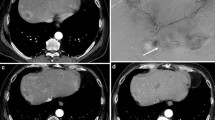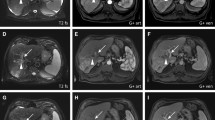Abstract
Purpose
This prospective study evaluated the effectiveness and safety of TACE using irinotecan loaded superabsorbent polymer (SAP) microspheres for treatment of colorectal cancer liver metastases (CCLM) in a salvage setting of patients.
Methods
A total of 71 TACE procedures were performed in 29 patients with liver only or liver-dominant CCLM. In all patients, systemic chemotherapy before TACE had failed. Two hundred milligrams of irinotecan were loaded into 50–100 mg of SAP microspheres (HepaSphere™ Microspheres) considering tumor size and vascularization. TACE was performed selectively with respect to tumor distribution. Response was evaluated following RECIST and EASL criteria, respectively. Median follow-up after last TACE was 8 (range 1–54) months. All patients had died at time of analysis.
Results
All TACE procedures were performed successfully; 35–400 mg (mean 168.3 mg) of irinotecan loaded in 13–100 mg (mean 48.3 mg) SAP microspheres were injected during individual sessions. No major complications occurred. Three, 6, and 12 months after first TACE complete and partial response was present in 72, 32 %, 0 of patients by EASL criteria and stable disease was seen in 86, 48, and 8 % with no complete and no partial response by RECIST criteria. Median overall survival after first TACE was 8 months, and median time to progression was 5 months. Median overall survival was longer in patients with limited (<25 %) compared with extensive (>50 %) intrahepatic disease (21 vs. 5 months, p < 0.005).
Conclusions
TACE using irinotecan loaded SAP microspheres is safe and effective in terms of tumor necrosis. Survival benefit in a salvage setting seems to be limited in patients with advanced intrahepatic tumor load.



Similar content being viewed by others
References
Pwint TP, Midgley R, Kerr D (2010) Regional hepatic chemotherapies in the treatment of colorectal cancer metastases to the liver. Semin Oncol 37:149–159
Saltz LB, Cox JV, Blanke C et al (2000) Irinotecan plus fluorouracil and leucoverin for metastatic colorectal cancer: irinotecan study group. N Engl J Med 343:905–914
Goldberg RM, Sargent DJ, Morton RF et al (2004) A randomized controlled trial of fluorouracil plus leucoverin, irinotecan, and oxaliplatin combinations in patients with previously untreated metastatic colorectal cancer. J Clin Oncol 22:23–30
Colucci G, Gebbia V, Paoletti G et al (2005) Phase III randomized trial of FOLFIRI versus FOLFOX4 in the treatment of advanced colorectal cancer: a multicenter study of the gruppo oncologico dell Italia meridional. J Clin Oncol 23:4866–4875
Chen HX, Mooney M, Boron M et al (2006) Phase II multicenter trial of bevacizumab plus fluorouracil and leucoverin in patients with advanced refractory colorectal cancer: an NCI treatment referral center trial TRC-0301. J Clin Oncol 24:3354–3360
Hurwitz H, Fehrenbacher L, Novotny W et al (2004) Bevacizumab plus irinotecan, fluorouracil, and leucovorin for metastatic colorectal cancer. N Engl J Med 350:2335–2342
Rothenberg ML, Oza AM, Bigelow RH et al (2003) Superiority of oxaliplatin and fluorouracil-leucovorin compared with either therapy alone in patients with progressive colorectal cancer after irinotecan and fluorouracil-leucovorin: interim results of a phase III trial. J Clin Oncol 21:2059–2069
Park SH, Sung JY, Han SH et al (2005) Oxaliplatin, folinic acid and 5-fluorouracil (FOLFOX4) combination chemotherapy as second-line treatment in advanced colorectal cancer patients with irinotecan failure. A Korean single-center experience. Jpn J Clin Oncol 35:531–535
Liapi E, Lee K-H, Georgiades CC, Hong K, Geschwind J-F (2007) Drug-eluting particles for interventional pharmacology. Tech Vasc Interv Radiol 10:261–269
Jordan O, Denys A, deBaere T, Boulens N, Doelker E (2010) Comparative study of chemoembolization loadable Beads: in vitro drug release and physical properties of DC Bead and HepaSphere loaded with Doxorubicin and Irinotecan. J Vasc Interv Radiol 21:1084–1090
Aliberti C, Tilli M, Benea G, Fiorentini G (2006) Trans-arterial chemoembolization (TACE) of liver metastases from colorectal cancer using irinotecan-eluting beads: preliminary results. Anticancer Res 26:3779–3782
Fiorentini G, Aliberti C, Turrisi G et al (2007) Intra-arterial hepatic chemoembolization of liver metastases from colorectal cancer adopting irinotecan-eluting beads: results of a phase III clinical study. In Vivo 21:1085–1092
Martin RCG, Joshi J, Robbins K et al (2009) Transarterial chemoembolization of metastatic colorectal carcinoma with drug-eluting beads, irinotecan (DEBIRI): multi-institutional registry. J Oncol 2009:539–544
Eisenhauer EA, Therasse P, Bogaerts J et al (2009) New response evaluation criteria in solid tumours: revised RECIST guideline (version 1.1). Eur J Cancer 45:228–247
Bruix J, Sherman M, Llovet JM et al (2001) Clinical management of hepatocellular carcinoma: conclusions of the Barcelona-2000 EASL conference. European association for the study of the liver. J Hepatol 35:421–430
Tellez C, Benson AB 3rd, Lyster MT et al (1998) Phase II trial of chemoembolization for treatment of metastatic colorectal carcinoma to the liver and review of the literature. Cancer 82:1250–1259
Leichman CG, Jacobson JR, Modiano M et al (1999) Hepatic chemoembolization combined with systemic infusion of 5-fluorouracil and bolus leucoverin for patients with metastatic colorectal carcinoma: a southwest oncology group pilot trial. Cancer 86(5):775–781
Hong K, McBride JD, Georgiades CS et al (2009) Salvage therapy for liver-dominant colorectal metastatic adenocarcinoma: comparison between transcatheter arterial chemoembolization versus yttrium-90 radioembolization. J Vasc Interv Radiol 20:360–367
Vogl TJ, Gruber T, Balzer JO et al (2009) Repeated transarterial chemoembolization in the treatment of liver metastases of colorectal cancer: prospective study. Radiology 250:281–289
Albert M, Kiefer MV, Sun W et al (2011) Chemoembolization of colorectal liver metastases with cisplatin, doxorubicin, mitomycin C, ethiodol, and polyvinyl alcohol. Cancer 117:343–352
Fiorentini G, Aliberti C, Tilli M et al (2012) Intra-arterial infusion of irinotecan-loaded drug-eluting beads (DEBIRI) versus intravenous therapy (FOLFIRI) for hepatic metastases from colorectal cancer: final results of a phase III study. Anticancer Res 32:3–11
Martin RCG, Robbins K, Tomalty D et al (2009) Transarterial chemoembolization (TACE) using irinotecan-loaded beads for the treatment of unresectable metastases to the liver in patients with colorectal cancer: an interim report. World J Surg Oncol 7(80):1–12
Martin RCG, Joshi J, Robbins K et al (2011) Hepatic intra-arterial injection of drug-eluting bead, irinotecan (DEBIRI) in unresectable colorectal liver metastases refractory to systemic chemotherapy: results of multi-institutional study. Ann Surg Oncol 18:192–198
Ghegediban S, Wassef M, Pelage J et al (2012) The choice of small size microspheres for a homogeneous distribution in embolized tissue. J Vasc Interv Radiol 23(Suppl):S62–S63
Jiaqi Y, Hori S, Minamitani K et al (1996) A new embolic material: super absorbent polymer (SAP) microspheres and its embolic effects. Nippon Igaku Hoshasen Gakkai Zasshi 56:19–24
Khankan AA, Osuga K, Hori S et al (2004) Embolic effects of superabsorbent polymer microspheres in rabbit renal model: comparison with tris-acryl gelatin microspheres and polyvinyl alcohol. Radiat Med 22:384–390
Bilbao JI, de Luis E, Garcia de Jalon JA et al (2008) Comparative study of four different spheric embolic particles in an animal model: a morphologic and histologic evaluation. J Vasc Interv Radiol 19:1625–1638
De Luis E, Bilbao JI, de Ciercoles JA et al (2008) In vivo evaluation of a new embolic spherical particle (HepaSphere) in a kidney animal model. Cardiovasc Intervent Radiol 31:367–376
Gupta S, Wright KC, Ensor J et al (2011) Hepatic arterial embolization with doxorubicin-loaded superabsorbent polymer microspheres in a rabbit liver tumor model. Cardiovasc Intervent Radiol 34:1021–1030
Osuga K, Khankan AA, Hori S et al (2002) Transarterial embolization for large hepatocellular carcinoma with use of superabsorbent polymer microspheres: initial experience. J Vasc Interv Radiol 13:929–934
Grosso M, Vignali C, Quaretti P et al (2008) Transarterial chemoembolization for hepatocellular carcinoma with drug-eluting microspheres: preliminary results from Italian multicenter study. Cardiovasc Intervent Radiol 31:1141–1149
Carmeliet P, Jain RK (2000) Angiogenesis in cancer and other disease. Nature 407:249–257
Oklu R, Walker TG, Wicky S et al (2010) Angiogenesis and current antiangiogenetic strategies for treatment of cancer. J Vasc Interv Radiol 21:1791–1805
Farris AB III, Dursun N, Dhanasekaran R et al (2012) Tumoral and angiogenesis factors in hepatocellular carcinoma after locoregional therapy. Pathol Res Pract 208:15–21
Jain RK (2005) Normalization of tumor vasculature: an emerging concept in antiangiogenic therapy. Science 307:58–62
Britten CD, Finn RS, Gomes AS et al (2005) A pilot study of IV bevacizumab in hepatocellular cancer patients undergoing chemoembolization. J Clin Oncol 23(16S):342s Abstr. 4138
Conflict of Interest
Peter Huppert, Thorsten Wenzel and Hubertus Wietholtz declare that they have no conflict of interest.
Author information
Authors and Affiliations
Corresponding author
Rights and permissions
About this article
Cite this article
Huppert, P., Wenzel, T. & Wietholtz, H. Transcatheter Arterial Chemoembolization (TACE) of Colorectal Cancer Liver Metastases by Irinotecan-Eluting Microspheres in a Salvage Patient Population. Cardiovasc Intervent Radiol 37, 154–164 (2014). https://doi.org/10.1007/s00270-013-0632-0
Received:
Accepted:
Published:
Issue Date:
DOI: https://doi.org/10.1007/s00270-013-0632-0




